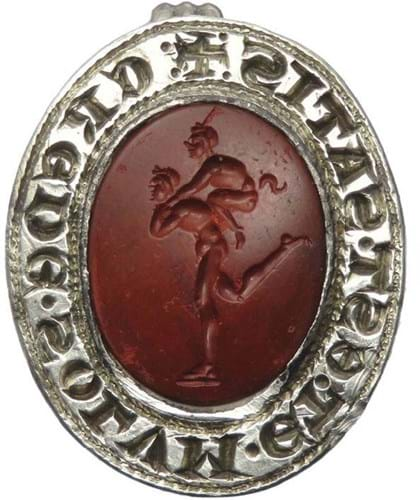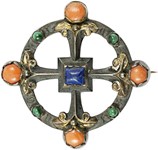
Silver seal matrix c.1200-1400 containing a Roman jasper intaglio of 2nd century date, £67,000 at Essex Coin Auctions.
A medieval seal matrix, unearthed in a Hampshire field on December 24, 2022, sold for a house record £67,000 at Essex Coin Auctions.
Dated to the 13th or 14th century, the 3cm matrix offered on March 16 combines elements of both medieval and ancient craftsmanship.
The silver mount, with a large circular lug for attachment, carries the inscription in reverse letters reading: Crede Solvm Et Est Satis (Believe only and it is enough), a phrase from the liturgical chant Missus Gabriel de Celis (Gabriel Sent from Heaven) sung at the feast of the Annunciation.
However, to the centre is a Roman (probably 2nd century) jasper intaglio engraved with the pagan image of two satyr, one with a tail and horns kneeling on the shoulders of the other.
Medieval period
Roman intaglios were clearly much admired in the medieval period as many were reused in jewellery and in seal matrices. The Oxford University professor Martin Henig (a specialist in engraved gems who recently played a role in the uncovering of thefts from the British Museum) wrote a paper on the subject for the British Museum research publication Good Impressions: Image and Authority in Medieval Seals (2008), titled ‘The reuse and copying of ancient intaglios set in Medieval personal seals, mainly found in England’.
An aspect of the renaissance of the 12th century, it states that ancient intaglios were often employed as privy or counter seals and were deemed more intimate and personal in nature than their official counterparts.
Adam Staples, co-owner of Brentwood-based Essex Coin Auctions, had first been shown pictures of the piece shortly after it had been reported through the Portable Antiquities Scheme and later returned to the lady who had found it by the British Museum.
“The quality of the intaglio was a key factor in the price”, he told ATG. “The vendor had been happy with the estimate of £3000-5000 we had given based on photographs, but it was so much nicer when in the hand. Before the sale we thought it might make £10,000-20,000.”
In fact, bidding took close to 20 minutes, creeping up in increments of £1000 as four UK phone bidders became two. As is the norm when detectorist finds are sold, the £67,000 proceeds will be split evenly between the finder and the landowner in Hart district.
Hoard sale
The price (close to £82,000 with the addition of 22% buyer’s premium) is the highest so far for Essex Coin Auctions which launched in July 2022, although not the most valuable auction lot handled by Staples.
He previously worked with Hansons in Derbyshire where he oversaw the sale of the so-called Ryedale Hoard for £185,000 in May 2021.
The group of four Romano British bronzes comprised non-precious metals and so did not qualify as treasure under the terms of the Treasure Act 1996 – the terms of which were amended last year.
Bought by London antiquities dealership David Aaron, the hoard was then sold to the Yorkshire Museum in York.












